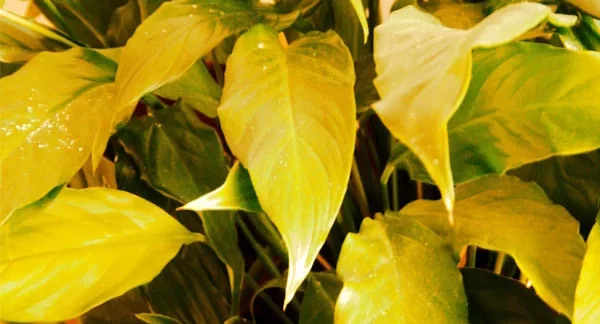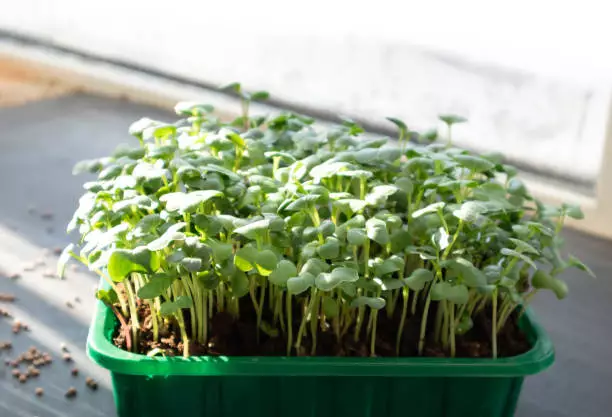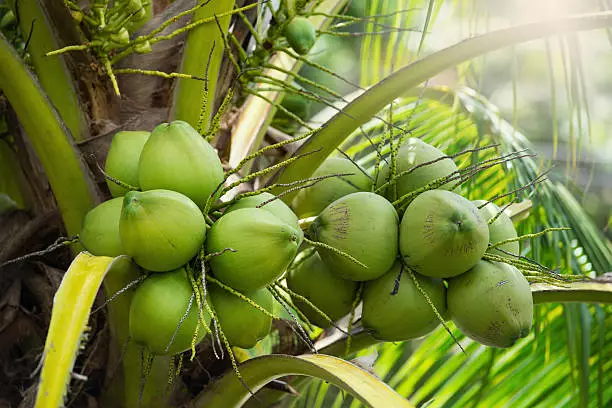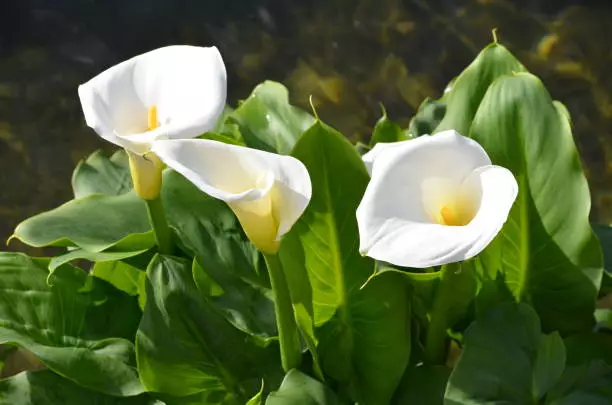The peace lily is an evergreen plant that naturally exists in tropical rainforests. Being a relatively small plant, it stays on the floor of the forests covered by a canopy of larger trees. It thus thrives in conditions with high humidity and moderate sunlight and water. In these conditions, the plant thrives and easily blooms.
Any changes in these conditions often lead to undesirable results with changes in color among the early signs of a problem. When the leaves of your peace lily change to a yellow color, it’s usually due to changes in the amount of light and water the plant is receiving. Other causes include environmental stressors, poor nutrition, pests, and diseases. The leaves could also just be old.
Why are the leaves of my peace lily turning yellow?

The two main causes of yellow leaves in peace lilies are:
1. Poor Lighting Conditions
Yellowing leaves on your peace lily are an indication of either too much or too little light getting to the plant. This is especially the case when the whole leaf is turning yellow. In the wild, the peace lily prefers rainforests where there is a canopy shielding it from direct sunlight.
Too much light would be a result of either putting the lily in a position where the sun directs hits it through the door, window, or another opening. Also, artificial light from a set of studio lights can affect the plant when it’s exposed for long periods of time.
Too little light can occur when the plant is getting almost no light. This can occur when the plant is located in a dark corner with hardly any light. Keep in mind that the plant can thrive even on fluorescent light alone. By the time it turns yellow due to the lack of light, it would be in quite a dark place.
2. Too Little Water
When the leaves of the peace lily turn yellow or brown on the edges and wilt, it’s a sign that you’re giving the plant too little water. If left for too long, the leaves and the plant itself may die off.
3. Pests and Diseases
The peace lily is most susceptible to the fungi Phytophthora parasitica and Cylindrocladium spathyphylli. Some of their common symptoms are the yellowing and wilting of leaves. The lower leaves are usually affected as they’re closer to the root and source of the disease than the upper leaves.
4. Poor Nutrition
Your peace lily needs fertilization only once in a while and in very small amounts. If, however, you take too long to feed it, it’ll develop signs to show that you’re not tending to it properly as far as fertilization is concerned.
The specific signs of poor nutrition in your peace lily include the following:
- Yellowing of the leaves with the veins remaining green is a sign of magnesium and iron deficiency.
- General leaf yellowing is due to the lack of nitrogen.
- Yellowing leaf tips are due to the lack of potassium.
The plant may also have stunted growth with the lack of nutrients.
5. Environmental Stresses
The other reason your plant’s leaves are turning yellow would be stress in the environment. These include the following:
- Temperature changes to either extreme cold or heat can lead to the yellowing of the leaves.
- Shock due to being transplanted. This occurs a few days after buying the plant or repotting it.
- Shock due to being moved to a new location with different lighting, temperatures, or humidity levels.
If you notice the yellow leaves in a new plant or one that’s had a significant change, it’s usually due to shock.
6. Aging Leaves
Like with all plants, some leaves get old and need to be shed off by the peace lily. If you’re sure of getting the conditions for the plant right and still see yellowing leaves, it’ll be a sign of old age. Such leaves will simply fall off and there isn’t a thing you can do.
How to turn the yellow leaves green again
The solutions to the above problems are as follows:
1. Adjust the Lighting Conditions
The simple solution to this is to give the peace lily the right amount of light. If it has turned yellow due to too much light, start by moving it to a place where there isn’t any direct sunlight or another form of intense direct light. Even if it’s close to a window, it should be a window facing to the north or south where there’s little chance of the sun hitting it directly. This, however, doesn’t mean a few moments of sunlight are harmful in any way.
If there’s too much light, move the lily close to a window of your choice keeping in mind not to expose it to too much direct sunlight. In both cases, always make sure it’s just the sunlight causing the change in color and other conditions are ideal for the plant.
2. Provide More Water
With the peace lily, there’s a delicate balance between overwatering and underwatering it. The best way to go about it is to only water the plant once the leaves are slightly wilted. This requires keeping a close eye on how the leaves look when turgid and when wilted.
If you water the plant too long after the leaves’ wilting, you run the risk of losing the leaves and the plant as a whole. When watering the plant, make sure you don’t give it too much water as that too is problematic. The safest way is to have a hole into the side of its pot that drains out any excess water after irrigation.
3. Treat Diseases and Pests
Treating diseases on your peace lily may require a visit to the lab with a sample of the plant to check the specific disease and what to do as a remedy. In some cases, the whole plant may need to be killed off, especially if the disease or pest has spread too much.
4. Proper Fertilization
The best fertilization routine should be a handful of fertilizers every 2 or 3 months. This should be done with a balanced fertilizer in the ratio of 20-20-20 for proper nutrition.
5. Eliminating Environmental Stressors
Heat, cold, humidity, and other environmental stressors can occur for a while and then go away usually after two weeks. The plant is expected to recover after this period. If not, you should restore the previous conditions before the plant dies off.
For the repotting, avoid adding any new soil to the plant in the new pot as it easily leads to the rotting of the roots and color changes in the leaves.
These are solutions you can easily find and apply to your plant. Always consult with the experts who sold you the plant whenever you see anything uncommon with the plant.
Can you cut the discolored leaves off a peace lily?
If the yellowing of the leaves is beyond salvation or it’s simply taking longer to heal, you can cut off the whole leaf. For leaves that only have yellow color on the edges, you don’t need to cut them off wholly. Rather, you simply need to trim off the affected areas and the leaf will remain in good condition.
To cut off the affected leaf, make sure you follow it all the way to the base of the stem and where it joins the main stem. For trimming, cut a short distance into the leaf and away from the edge. A trimmed leaf will have a dry edge but only for a while.
The one thing to always keep in mind when cutting off or trimming discolored leaves is to sterilize the tools you’ll be using. This reduces the chances of contamination since the plant is highly susceptible to diseases, especially fungi.



